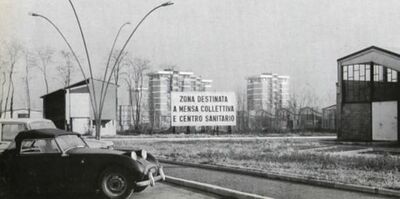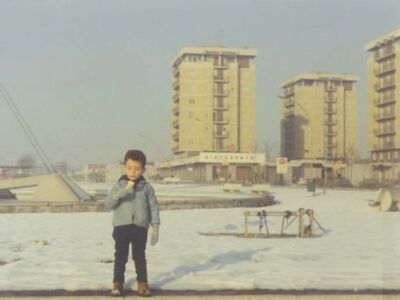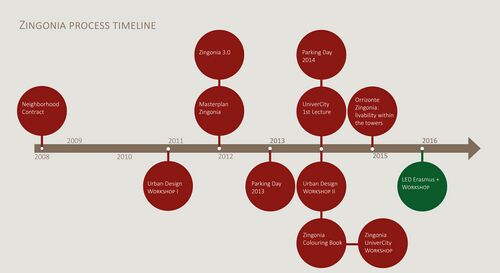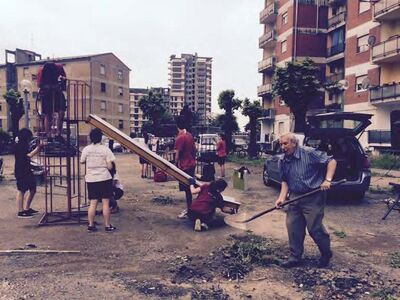LED Workshop Zingonia 2016: Difference between revisions
No edit summary |
|||
| Line 9: | Line 9: | ||
[[File:Zingonia playground construction.jpg|thumb|right|400px]] | [[File:Zingonia playground construction.jpg|thumb|right|400px]] | ||
== Introduction == | == Introduction == | ||
The June 19-29, 2016 intensive program/workshop | The June 19-29, 2016 intensive program/workshop gave online seminar participants the opportunity to apply theory and methods to a real case study, the New Town of Zingonia, in Northern Italy. | ||
During the Zingonia workshop participants | During the Zingonia workshop participants used some of the theories and tools investigated in the online seminar to analyze the complex landscape of the New Town, its challenges with regard to landscape democracy and identify possible solutions. In partnership with local stakeholders (associations, schools, administrative boards…), students enrolled in the intensive workshop will draw attention to places where specific strategies can be activated to improve livability, democracy, identity and long term resilience. | ||
For further information on the Zingonia case you may listen to an online lecture given by Dr. Deni Ruggeri (NMBU Norway) on November 17, 2015: | For further information on the Zingonia case you may listen to an online lecture given by Dr. Deni Ruggeri (NMBU Norway) on November 17, 2015: | ||
* [https://ilias.hfwu.de/goto.php?target=cat_12806&client_id=hfwu The story of Zingonia, Italy - Using storytelling in planning for diversity and multiculturalis (open access)] | * [https://ilias.hfwu.de/goto.php?target=cat_12806&client_id=hfwu The story of Zingonia, Italy - Using storytelling in planning for diversity and multiculturalis (open access)] | ||
== Why Zingonia? == | == Why Zingonia? == | ||
| Line 76: | Line 54: | ||
== Zingonia process since 2008 == | == Zingonia process since 2008 == | ||
2008: Neighborhood Contract | |||
2011: Urban Design Workshop I | |||
2012: Zingonia 3.0 & Masterplan Zingonia | |||
2013: Parking Day | |||
2014: Parking Day & UniverCity 1st Lecture & Urban Design Workshop II & Zingonia Colouring Book & Zingonia UniverCity Workshop | |||
2015: Orizonte Zingonia: livability within the towers | |||
== Interactions == | == Interactions == | ||
| Line 104: | Line 77: | ||
*The “Quelli della Zingonia” facebook group | *The “Quelli della Zingonia” facebook group | ||
The workshop | The workshop has interacted with these stakeholders, trying to build relationships among different subjects and contributing to the development of a common new design. | ||
== workshop related additional ressources == | == workshop related additional ressources == | ||
''[https://ilias.hfwu.de/ilias.php?ref_id=15482&cmd=view&cmdClass=ilrepositorygui&cmdNode=hr&baseClass=ilRepositoryGUI Randy Hester-Actions for Interdependence]'' | ''[https://ilias.hfwu.de/ilias.php?ref_id=15482&cmd=view&cmdClass=ilrepositorygui&cmdNode=hr&baseClass=ilRepositoryGUI Randy Hester-Actions for Interdependence]'' | ||
Revision as of 08:57, 2 November 2017
Introduction
The June 19-29, 2016 intensive program/workshop gave online seminar participants the opportunity to apply theory and methods to a real case study, the New Town of Zingonia, in Northern Italy. During the Zingonia workshop participants used some of the theories and tools investigated in the online seminar to analyze the complex landscape of the New Town, its challenges with regard to landscape democracy and identify possible solutions. In partnership with local stakeholders (associations, schools, administrative boards…), students enrolled in the intensive workshop will draw attention to places where specific strategies can be activated to improve livability, democracy, identity and long term resilience.
For further information on the Zingonia case you may listen to an online lecture given by Dr. Deni Ruggeri (NMBU Norway) on November 17, 2015:
Why Zingonia?
Zingonia is a paradigmatic case study for the discussion on landscape and democracy. Its multicultural community, its Modernist physical environments and its unique governance and long term resilience challenges will require students to develop and test here strategies and representation methodologies which may be applicable to other similar contexts. The scheme below lists the main themes or layers which the participants will focus on. The second column specifies critical issues connected to each theme.
Social layer - Zingonia, the New Town
All inhabitants are 'immigrants' - we find a multitude of communities. Each citizen belongs to many communities, and each community occupies a physical landscape.
- What is the “space-LANDSCAPE?” of each community?
- Where is each community’s identity center, its sacred space?
- Which kind of geography emerges from the representation of these spaces and centers?
We will consider which community is located where. They may reside in different places within a city which was not previously considered. We will learn how to map existing and strategically locate new community spaces.
Historical layer - Zingonia is a 50 year-old New Town
- What is the relationship between the city and its history?
- How can the landscape of a New Town represent a community’s history, social memories and traditions?
- What is the relationship between citizens and collective memory?
We will consider the landscape as a place to narrate the evolution of a community.
Aesthetic layer - Zingonia’s original plan was not the result of a 'participatory' process
Nevertheless, Zingonia presents a recognizable form.
- What does Zingonia say about the role of designers and planners as experts and how should design and planning decision be made?
- Is there a connection between democracy and the quality of urban design? The fresco of Buon Governo in Siena (Lorenzetti, 1338) introduces this parallelism as a certainty. Thinking about landscape democracy in contemporary cities requires challenging old assumptions.
- Is there a democratic landscape aesthetic for contemporary cities?
- Is Democracy 'visible'?
Economic layer - From a Zingonia 'city of the italian miracle' to Zingonia, the post-industrial community
Changes in system of industrial production challenge designers and planners to redesign or re-purpose industrial areas and their infrastructure to support new uses.
- What is the role of citizens in this process of conversion/re-envisioning?
Identity layer - Connection and disconnection of a community to its real/virtual image
While the virtual world may help a democracy by giving voices to non-dominant images of the city, we need to become aware of the limitations that the virtual layer can create in the relationship between citizens and a physical space.
- What is the role the landscape of Zingonia plays as a structuring element of its identity (identities)?
- What is the relationship between real and virtual landscapes?
- Which tools do citizens of today have to represent their community and envision its future identity?
Zingonia process since 2008
2008: Neighborhood Contract 2011: Urban Design Workshop I 2012: Zingonia 3.0 & Masterplan Zingonia 2013: Parking Day 2014: Parking Day & UniverCity 1st Lecture & Urban Design Workshop II & Zingonia Colouring Book & Zingonia UniverCity Workshop 2015: Orizonte Zingonia: livability within the towers
Interactions
Zingonia is a town where a process of regeneration is taking place. A number of residents, companies, associations and institutions have begun to collaborate with local and foreign partners to develop new visions for the future. Universities have already intervened in this process with a project of urban analysis particularly dedicated and realized in collaboration with local school students.
This program has been useful to identify communities and stakeholders such as:
Institutions:
- 5 municipalities;
- one local public school
- the local Catholic Parish
Associations:
- Senegalese Association
- “Orti Sociali” [community gardens] association
Groups:
- Citizens
- The “Quelli della Zingonia” facebook group
The workshop has interacted with these stakeholders, trying to build relationships among different subjects and contributing to the development of a common new design.








